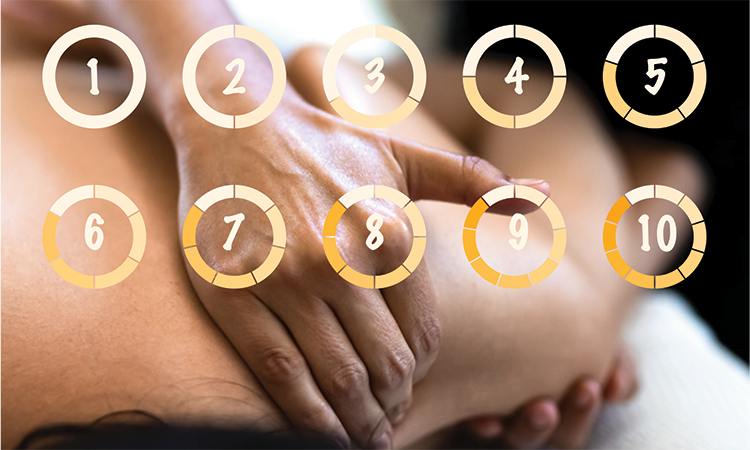Some clients don’t rebook because they wanted more massage pressure and were afraid to ask for it. Other clients might not return because massage pressure was too deep—and instead of speaking up, they decided to find another therapist.
I learned to design a more proactive approach to sessions in order to work with clients to create pressure that works for them (and rebookings for my practice).
Earlier in my career, I had the opportunity to be a student-massage-clinic supervisor. It was a stressful job because it was my responsibility to get all the appointments filled for the students. I found myself spending a lot of time calling in people at the last minute to offer them free massages to fill time for students to get their required clinic hours.
Because of low rescheduling rates, I was tasked with figuring out how to get more of the clinic clients to become repeat clients. I decided the easiest thing to do was ask these clients what the students could improve on to get them to want to come back.
The most suggested improvement was to teach our students to apply the right kind of pressure. This request surprised me because I thought we were teaching our students how to apply correct pressure. Regardless, I had my answer. What our clinic clients were struggling with was their pressure needs and wants were not being met.
Our students were somehow missing how to combine applied massage strokes while using correct pressure to tailor the massage uniquely for each client. They were offering pressure, but it was more of just going deeper, not skillfully applying it.
Perceptions of Pressure
When I talked with the students about this, their answers were interesting. Many were confused because they equated pressure with simply going deeper, and were unsure of what they needed to change to create better pressure. Several said that when questioned, clients would typically remark that the pressure was “fine,” adding further to the confusion.
A communication issue was creating confusion between what the student perceived as good massage depth and what the client actually hoped the therapist would offer. It was also clear many clients did not want to discourage the students in training and therefore weren’t being completely honest about their needs. This was negatively impacting the students’ ability to learn correct massage depth—and clients were not returning.
Quantifying Pressure
We needed a different way to teach communication for pressure needs between the student and clinic client.
I tried a little experiment and trained the students to use what I called a pressure scale. I derived this scale from the 1-10 pain scale we used to understand a client’s pain level and simply turned it into a measurable pressure gauge for student and client.
I told students to no longer use words such as “fine, good or OK” to determine if pressure was satisfactory. We would use this numbering system instead so students could begin working with up to 10 levels of pressure depth. This way they could focus on creating depth options for clients along with their technique practice.
What happened was so fascinating and profound that I teach this concept to massage professionals who want to get more clients to reschedule.
Pressure Perfection
To use the pressure scale, I came up with a simple question to ask the client before the session: “If someone were to come up and start rubbing your shoulders on a scale of 1-10, one being no pressure at all and 10 being too much, where would you like the pressure of the massage to be?”
Once the client states the number they want, I teach students it is imperative that they achieve this pressure number during the session for the client to have their expectations met. I also taught them that it was not always about applying that number for a full session. Many times it was about that specific pressure in certain areas the client identified.
While in session, students started asking the clients if the pressure being applied was the number they picked. If it was not, the client could easily direct the student to the desired depth simply by giving them another number.
My students were shocked to learn what they thought was enough pressure was nowhere near what many clients wanted; often what they thought was controlled pressure was too heavy. This simple scale quickly taught students how to fine-tune their pressure. Our clinic clients responded beautifully, earning us a full schedule and rebooking weeks in advance shortly after implementation of the scale.
However, something even greater occurred from using this pressure scale.
What the Numbers Taught Us
The numbers on that scale began to teach us when a client was afraid of pressure or frustrated with a lack of pressure so the therapist could design a more proactive approach to the session.
For most sessions, a typical request was somewhere between a 5, 6 or 7 pressure level. These clients were easy to work with and the pressure was simple to refine for their expectations.
When we asked the shoulder-rubbing question and a client requested pressure either below 5 or above 7, there was typically an emotion behind the request that needed to be addressed before the massage could become what the client wanted it to be.
When a client wanted something below 5, such as a pressure level of 2 or 3, the client was telling us they had a fear of being hurt or possibly were afraid of the unknown, such as a first-time massage client. This client was attempting to control the situation through less pressure to be safe. If the student gave them the lowered pressure, the client was unsatisfied because the pressure did not meet their expectation of how they thought they would feel afterward. This left the students confused because while they did what the clients asked, the clients seemed unsatisfied and didn’t reschedule.
On the opposite end of the spectrum, if pressure requests were above 7, such as 8, 9 and 10, the client was telling us their pressure needs so far had been unmet. They wanted deep pressure or felt deeper pressure would create the change their muscles needed, and they had not found the relief they sought.
This client would ask for more pressure than they actually needed. If a student offered this deeper pressure, many times the massage was uncomfortable, and the client would leave feeling overworked with possibly more pain. The client did not receive what they were expecting in this situation either. Clients left feeling unsatisfied, with the student confused again.
I taught students it was our responsibility to realign each client’s expectations to a 5, 6 or 7, to let the client experience different depths and decide what they truly want. During the session the students would try out different pressures, ask the client what level that was to them and then ask what level they actually wanted. Most confirmed they did want a 5, 6 or 7 pressure and when using the numbered scale could direct the therapist to back off or press a little harder, knowing they were at the perfect pressure when the number was correct.
The Power of Correct Pressure
This pressure scale has been such an empowering teaching tool for massage students and professionals. As a continuing education provider, I have found it rewarding to observe how this scale quickly teaches a skill I believe otherwise takes most therapists a few thousand massages to figure out.
When you learn to apply refined, correct pressure for each person’s unique needs, you have created the greatest potential for a repeat client. When you know how to meet clients’ perfect pressure expectations, they will come back to you.

About the Author
Amy Bradley Radford, LMT, BCTMB, has been a massage therapist and educator for more than 30 years. She is the owner of Massage Business Methods and the developer of PPS (Pain Patterns and Solutions) Seminars CE courses and an NCBTMB Approved CE Provider.
